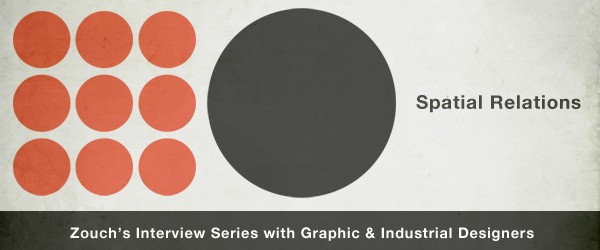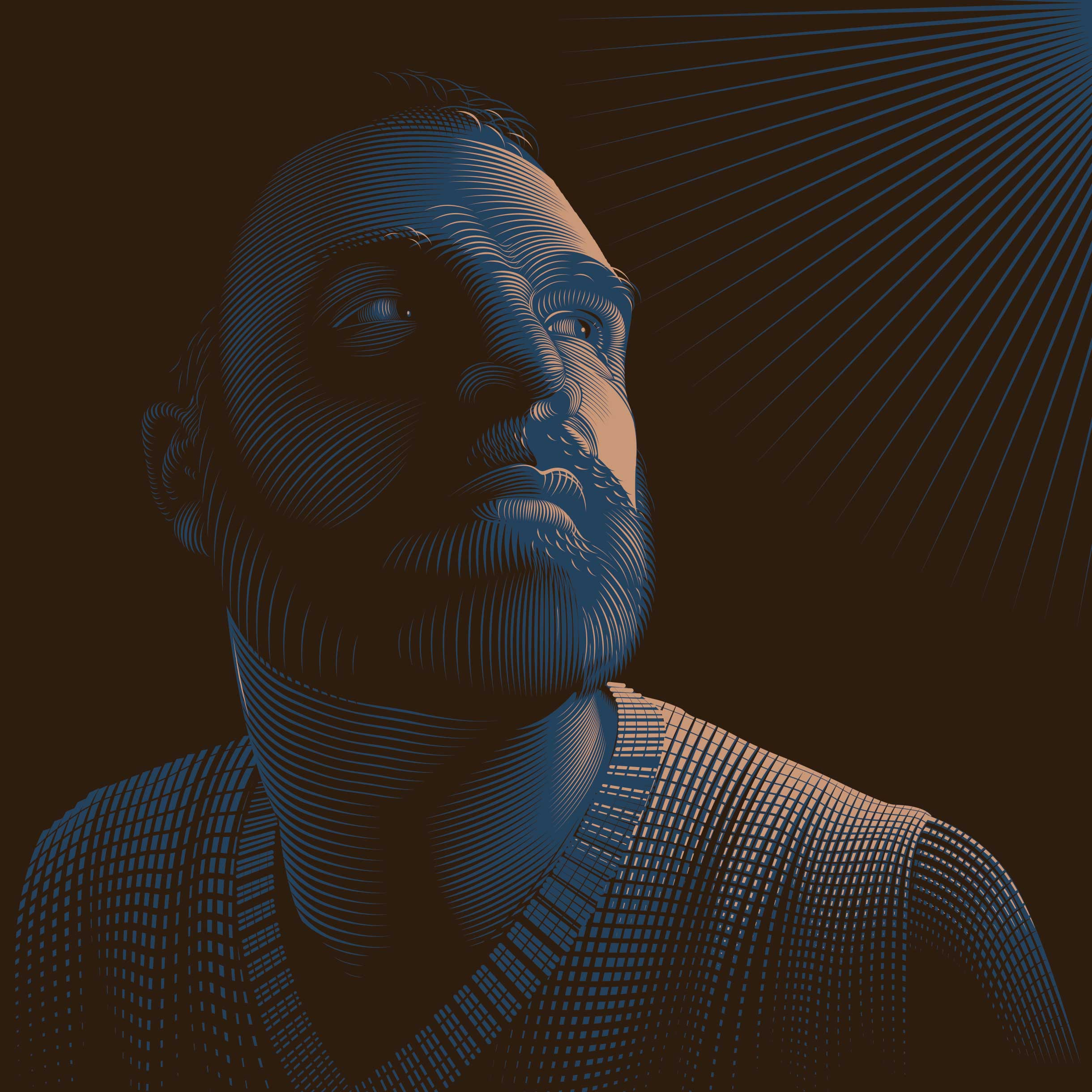
Spatial Relations #1 – An Interview with Christopher Evans
Interviews, Spatial RelationsChristopher Evans is a Connecticut-born graphic designer, illustrator, and silkscreener currently based in Paris, France.
Christopher’s design “dream team” would include an intimidating “Murderers’ Row” — Carl Jung, Hillary Clinton, Alice (presumably of Wonderland fame), et al. — and under editorial duress, he suggests movable type is mankind’s most beautiful creation. (Here’s looking at you, Baskerville!)
1) What made you want to become a graphic or industrial designer?
I had always been creative, and my very first dream was to become an artist. When i was in art school, i did a lot of sculpture: very large, metal and/or wood structures. At the time i struggled a lot with the question: “Does this thing justify the space its occupying?” Owning Art is a luxury for those with space, and space was a very scarce commodity in new york city. (and still is!).
With design, this question is non-existant. The need, and therefore the justification, is built right in. “Its a chair, you sit on it.” With painting and drawing its the same thing: “Does this thing deserve a place on a wall?” With graphic design, again, we avoid the question. “Its a poster, its informing people about an event.”
I wasn’t at all ready to justify and defend my Art at that time.
Once i discovered and fell in love with typography, becoming a graphic designer became evident.
2) Who are your influences?
I’m terrible at remembering names! I’ve never been one to be up on the latest thing, or aware of “the scene.” I know that there are great artists and designers out there that i admire greatly, but their names escape me.
That said, here are a few names i was able to scrape out of my brain: shepard fairey, hokusai, ellen lupton, gustave doré, william morris, michael beirut, andy warhol, bradbury thompson, the flemish primitives, ryan mcginness, louise fili, john tenniel, roy lichtenstein, banksy …
3) What design movement(s) do you most identify with?
I used to think that the whole of art history culminated in the modernist movement, and that there was really no need to move beyond that. Post modernism was a validation of that belief, since it was simply a re-hash of what came before modernism. I now realize that we’re all, still, post-modernists in our own ways… and that , although i still adore the concepts of modernism (and all the wonderful movements that modernism encompasses; like the bauhaus, de stijl, cubism, the international style, etc.) i am constantly being inspired by past periods in art and design history.
I probably identify most with the arts and crafts movement of the late 19th, early 20th c. I find myself simultaneously using technology (the computer) and hating the way its software and applications make contemporary design so predictable and homogenous. This must be similar to those artists, designers and architects who were fighting against the industrialization of their day, yet often using new technology in their production.
4) How would you describe your “process”?
The first thing i do is try and pick out the different patterns and motifs hiding in the original image that i’m drawing from. In a way, its not very different from an engraver back in the 19th century who is tasked with translating a painting or photograph into line-art for reproduction. Rather than using a flat dot screen to create the different levels of tone, i try to use a whole palette of shapes and lines to create the effect of volume.
This is why i call these drawings “digital woodcuts.” The image is created with vector-shapes in Adobe-Illustrator, yet there is no use of computer automation. Some people look at the work and assume that there is Photoshop filter doing it, or even a 3D software applying motif to a virtual shape.
The only filters are my eyes. (which can get really tired at times!)
5) What work(s) or project(s) do you consider your masterpiece(s)?
There are definitely no masterpieces here. Not yet anyway.
I do, however, feel that every drawing teaches me something; a new technique, a new way to create a certain desired effect. In this way, I sometimes feel that a masterpiece may possibly be somewhere in my future.
I still consider my work to be “in progress.”
6) What are you working on right now?
I am currently working on a book cover for Puffin books in London. Its for a collection of classic children’s stories. The one i’m working on is a novel from the early 60’s by Philippa Pierce called “A Dog so Small.”
7) What’s your next project?
A wedding portrait for a very dear friend.
8) How would you describe or categorize contemporary design?
Like i mentioned earlier, i think we’re still in a post-modernist world… or maybe a post-post-modernist one.
It seems to me that, on a whole, we have finally assimilated computers and software into our industry in a way that now appears much more seamless. I feel like its taken 25 years for this … but designers seem to be moving on and beyond the confines of “look what i can do with a computer!” and now use technology as a means to an end: toward a more personal vision.
The popularity of hand-lettering is an example of this … often evoking long-gone eras like the 1930’s, or the19th century. The ‘Maximalist’ movement is another example of how we seem to have embraced the surreal and cacophonous worlds that seem so ‘anti-computer’ to me.
Also, with so many avenues available to us for publishing and getting our design out there … in a world that seems to value the designer more than any time in the past… it seems to me that there is, more than ever before, an endless stream of styles and movements. It has always been difficult to categorize the present moment, but i have a feeling that this might be more true today than ever.
9) What design movement(s) or designer(s) do you dislike?
Memphis Milano.
10) What characterizes your work or style?
Motif, repetition of form, halftone, directional lines to create volume, reduced color palette.
11) What is the most beautiful man-made thing you’ve ever seen?
I don’t think i’ve ever heard a more difficult and unfair question!
But if i had to choose one human creation over all others, it would be moveable type.
And if i had to choose one typeface over all others, it would be Baskerville.
12) What’s the most exciting thing about your profession?
What i find most exciting about being a graphic designer is being able to enter vastly different worlds via the clients we work for. I have had the opportunity to work for some very disparate industries… such as cultural institutions, luxury products, heavy industry, textiles, fine cuisine and catering, corporate banking, the medical profession, architecture studios, education, professional baseball… and the list goes on! Each time i am hired, i need to learn about this new world and about what makes it tick. I need to know what others are doing, design-wise, in the same field, and to find something about it that i personally find interesting. Otherwise, i wouldn’t be able to do my best work.
13) Which designer(s) should we keep an eye on?
I’m really not the kind of person that keeps up on all the latest trends. My work is pretty solitary, so i’m not in contact with my contemporaries like some designers are. Although it would be a waste of space by not mentioning somebody here.
I have a friend who’s work i admire enormously, but i wouldn’t be the first to announce his rise to fame. The french artist Julien Salaud creates stunning sculptures from taxidermy animals. I feel that we are both turning around some of the same issues and inspirations.
14) Who would be on your “fantasy design team”?
carl jung, joseph campbell, andy warhol, marcel duchamp, hillary clinton, walt disney, heironymus bosch, alice … and me. That makes 9. I think that’s the number needed for baseball, no?

Christopher Evans was born in 1968 in New Haven, CT and currently lives in Paris, France. He was educated at the Cooper Union School of Art (BA) and has worked with graphic design agencies in New York and Paris where he’s lived and worked since 1991. He co-founded the Evansandwong design firm with the architect/designer Victor Wong, which explored fashion and clothing from a conceptual perspective, produced clothing collections and runway shows, and published the evansandwongcatalogue: an annual art and design mail-order catalogue that featured the collaborative work of artists and designers.
Chris was recently a partner at JLA and Partners — the communication design firm created by Jean-Louis Azizollah — and presently works as a freelance graphic designer, illustrator, and silkscreener.






















